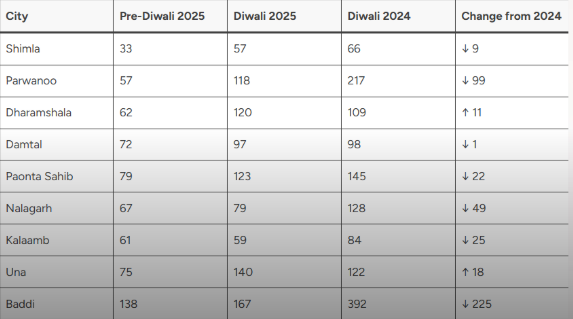Himachal Pradesh recorded improved air quality during Diwali 2025 compared to the previous year, with no location falling into the ‘poor’ or ‘severe’ category, according to a report released by the State Pollution Control Board (SPCB) on Wednesday. The monitoring, conducted from October 13 to October 19, covered the pre-Diwali period and the festival day itself across 12 cities and towns in the state.
The report reveals a significant improvement in most monitored locations, though some areas witnessed a decline, raising questions about localized pollution sources and enforcement measures.
Complete AQI Data: Diwali 2025 vs. 2024
| City | Pre-Diwali 2025 | Diwali 2025 | Diwali 2024 | Change from 2024 |
|---|---|---|---|---|
| Shimla | 33 | 57 | 66 | ↓ 9 |
| Parwanoo | 57 | 118 | 217 | ↓ 99 |
| Dharamshala | 62 | 120 | 109 | ↑ 11 |
| Damtal | 72 | 97 | 98 | ↓ 1 |
| Paonta Sahib | 79 | 123 | 145 | ↓ 22 |
| Nalagarh | 67 | 79 | 128 | ↓ 49 |
| Kalaamb | 61 | 59 | 84 | ↓ 25 |
| Una | 75 | 140 | 122 | ↑ 18 |
| Baddi | 138 | 167 | 392 | ↓ 225 |
| Barotiwala | 81 | 94 | 139 | ↓ 45 |
| Manali | 23 | 62 | 80 | ↓ 18 |
| Sundernagar | 50 | 68 | 104 | ↓ 36 |
The most dramatic improvement was recorded in Baddi, an industrial hub, where the Air Quality Index (AQI) dropped from 392 in 2024 to 167 in 2025—a reduction of 57%. Despite this significant improvement, Baddi still recorded the highest AQI among all monitored locations, remaining in the ‘moderate’ pollution category and highlighting persistent industrial emission concerns.
Parwanoo showed substantial improvement, with AQI falling from 217 last year to 118 this Diwali. Barotiwala’s AQI improved from 139 to 94, while Nalagarh recorded a decline from 128 to 79.
Concerningly, Two Cities Record Decline
However, not all news was positive. Dharamshala and Una bucked the trend, recording increased pollution levels compared to 2024. Dharamshala’s AQI rose from 109 to 120, while Una saw an increase from 122 to 140. The reasons behind this localized deterioration remain unexplained in the official report, raising questions about enforcement of firecracker bans and local emission sources in these towns.
Pre-Diwali vs. Diwali Day: The Festival Impact
The data reveals an expected spike in pollution levels on Diwali day compared to the pre-festival period across all locations. This pattern demonstrates the direct impact of firecracker bursting and increased celebratory activities, despite awareness campaigns and partial restrictions.
The most significant festival-day spike was observed in Una, where AQI jumped from 75 (pre-Diwali) to 140 (Diwali day). Baddi recorded an increase from 138 to 167, while Dharamshala saw a rise from 62 to 120.
Interestingly, smaller towns like Kalaamb showed minimal impact, with AQI actually declining slightly from 61 to 59, suggesting better compliance or lower population density reducing the firecracker effect.
Industrial Belts Remain Hotspots
The consistently higher baseline pollution in industrial areas like Baddi (pre-Diwali AQI: 138) compared to tourist destinations like Manali (pre-Diwali AQI: 23) and Shimla (pre-Diwali AQI: 33) underscores the ongoing challenge of industrial emissions in the state.
Even on Diwali day, Manali’s AQI remained at a relatively clean 62, while Shimla recorded 57—both well within the ‘satisfactory’ category. This stark contrast with industrial towns raises questions about year-round pollution control measures in manufacturing zones.
Understanding the AQI Categories
According to the Air Quality Index classification:
- Good (0-50): Minimal impact on health
- Satisfactory (51-100): Minor breathing discomfort for sensitive people
- Moderate (101-200): Breathing discomfort for people with lung, heart disease
- Poor (201-300): Breathing discomfort for most people on prolonged exposure
- Very Poor (301-400): Respiratory illness on prolonged exposure
- Severe (>401): Affects healthy people and seriously impacts those with existing diseases
While no Himachal location entered the ‘poor’ or worse categories this Diwali, the persistence of ‘moderate’ levels in industrial areas indicates room for improvement.
What explains the overall improvement?
Several factors may have contributed to the year-on-year improvement:
- Weather Conditions: Favorable meteorological conditions, including wind patterns and temperature, could have aided pollutant dispersion
- Awareness Campaigns: Increased public awareness about firecracker pollution may have reduced their use
- Administrative Measures: Stricter enforcement of firecracker sales and usage restrictions
- Industrial Regulations: Enhanced monitoring of industrial emissions in key pollution hotspots
However, the SPCB report does not provide analysis of which factors were most significant, leaving the improvement’s causes somewhat uncertain.
While the overall improvement is encouraging, the localized increases in Dharamshala and Una, combined with persistently elevated levels in industrial areas, suggest that Himachal’s air quality management requires sustained attention.
The state’s advantage of being a largely hilly, forested region with lower population density compared to plains states like Punjab and Haryana provides a natural buffer against severe pollution. However, unchecked industrial expansion and seasonal firecracker burning during festivals remain areas requiring continuous monitoring and stricter enforcement.
The challenge now lies in maintaining this improvement throughout the year, particularly in industrial belts, and understanding why some towns showed deterioration despite state-wide campaigns. Without detailed analysis of emission sources and enforcement effectiveness, declaring victory over air pollution would be premature.




